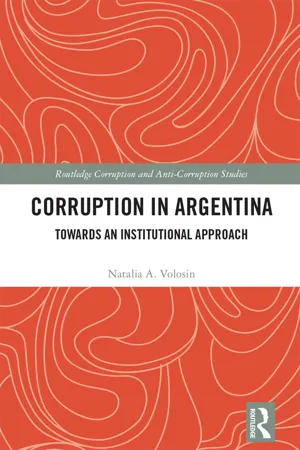[i]f we want to put a virtual end to bribery and corruption, what we really have to rely on are individual values and character traits… .
If we want to really get at corruption, what we need to build up are values of honesty and integrity in society… . Honesty, prosocial preferences and a sense of right and wrong constitute a part of the human psyche … even though we can create societies were such traits are barely visible.10
In the specific Latin American context, Guillán Montero explains that cultural conceptions:
[S]ee corruption in Latin America as an endemic problem which reflects deep cultural traditions – including legacies of patrimonial, corporatist and populist states – and prevailing values of particularism, formalism and discretionality; … limited economic opportunities and vulnerability of the middle classes; … low political trust; … and the presence of strong personal ties of family and friendship.11
This cultural approach, which, as we will see in Chapter 2, is key to Argentina’s futile debates on corruption, is opposed by institutional conceptions presented by theorists such as Susan Rose-Ackerman, Lawrence Lessig, Michael Johnston, Johann Lambsdorff, Andrei Schleifer and Robert Vishny.12 Institutional theories posit that corruption occurs because of, and as a reaction to, a particular set of social, political and/or economic rules and structures. These analyses vary in both subtle and more substantial ways depending on just how much (and exactly what) they include as relevant variables to provide incentives and opportunities for corrupt behavior to emerge.
Within the vast institutional literature on corruption, I embrace Rose-Ackerman’s approach. Her theory acknowledges the relevance of cultural norms. In the first edition of her groundbreaking book Corruption and Government (1999), she claimed, for instance, that “the definition of bribes and gifts is a cultural matter.”13 In the second edition of the book (2016), written with Bonnie Palifka, she makes a detailed assessment of the cultural argument. The authors argue that while legal rules and cultural norms help determine whether a transaction is either a price, a bribe, a gift or a tip (categories that Rose-Ackerman had already addressed in depth in 1999), these are not fixed standards, neither in space nor in time:
[i]f a payment is legally a bribe but is viewed as a tip, should the law be changed to remove the offense, or does the payer’s tolerant attitude undermine important policy goals? In other words, cultural or social practices are not immutable and can be normatively unacceptable.14
Furthermore, Rose-Ackerman and Palifka expressly assess the concept of “trust,” which is typically used within cultural studies of corruption. They distinguish between generalized, particular, and institutional trust and claim that while some types can sustain corruption (for instance, that between public officials and their friends and family), other types (trust in the impartial behavior of institutions) “make honest and competent government possible.”15 Carlos Nino makes this same distinction regarding Argentina when noting that behind corruption “there is often a moral that privileges family and friendship over public interest.”16 Rose-Ackerman and Palifka also show how, in a given context, trust can be not just a cultural variable based on inherent traits of integrity and honesty but also a product of rational, self-interested calculation.17 Finally, they study both virtuous and vicious cycles between cultural values and corrupt opportunities and conclude that corruption can undermine honesty, which, in turn, yields more corruption.18
The question remains, however, as to whether anticorruption efforts necessarily demand a change in cultural or moral traditions. As Rose-Ackerman explains, a despaired option suggests that “countries cannot escape their history” because corruption is determined by “deep cultural, historical and social factors.”19 This view, in turn, comes in two forms. The first is cultural essentialism, which has been defined as the notion that “a particular putative culture – a people‘s putative culture – forms the basis of the identity of each individual born of that society, in an immutable, irrevocable manner.”20 In Chika Mba’s words, “[f]or the cultural essentialist, a culture and its practices are not merely emblematic of a people’s identity; every individual member of any given society possesses a uniquely shared ‘cultural identity.’ ”21
Samuel Huntington’s division of the world in seven or eight civilizations is a clear-cut example of modern cultural essentialism: “[c]ultures can change, and the nature of their impact on politics and economics can vary from one period to another. Yet the major differences in political and economic development among civilizations are clearly rooted in their different cultures.”22 These comprehensive, long-lived cultural identities, “broadest cultural entities,” or cultures writ large are dynamic but only in an evolutionary sense.23 Within these terms, Latin America is thus described as having “a distinct identity which differentiates it from the West.”24 In Huntington’s words,
[a]lthough an offspring of European civilization, Latin America has evolved along a very different path from Europe and North America. It has had a corporatist, authoritarian culture, which Europe had to a much lesser degree and North America not at all. Europe and North America both felt the effects of the Reformation and have combined Catholic and Protestant cultures. Historically, although this may be changing, Latin America has been only Catholic. Latin American civilization incorporates indigenous cultures, which did not exist in Europe, were effectively wiped out in North America, and which vary in importance from Mexico, Central America, Peru, and Bolivia, on the one hand, to Argentina and Chile, on the other. Latin American political evolution and economic development have differed sharply from the patterns prevailing in the North Atlantic countries. Subjectively, Latin Americans themselves are divided in their self-ident...
